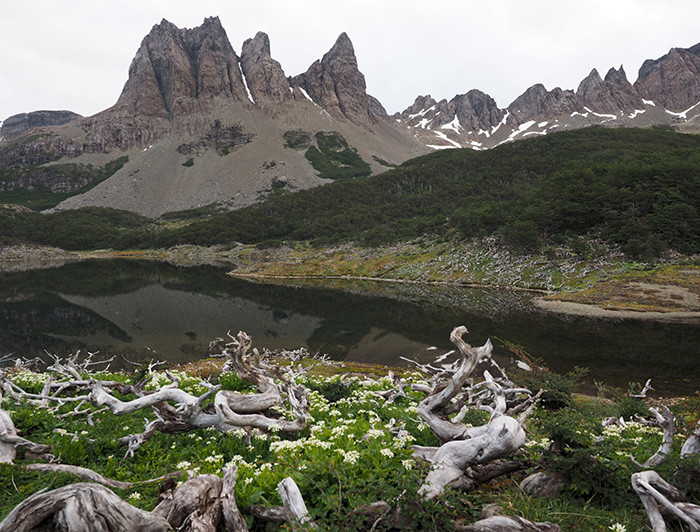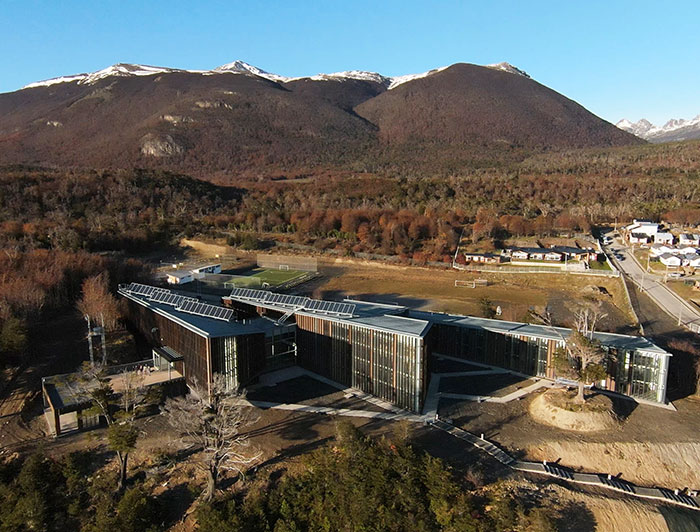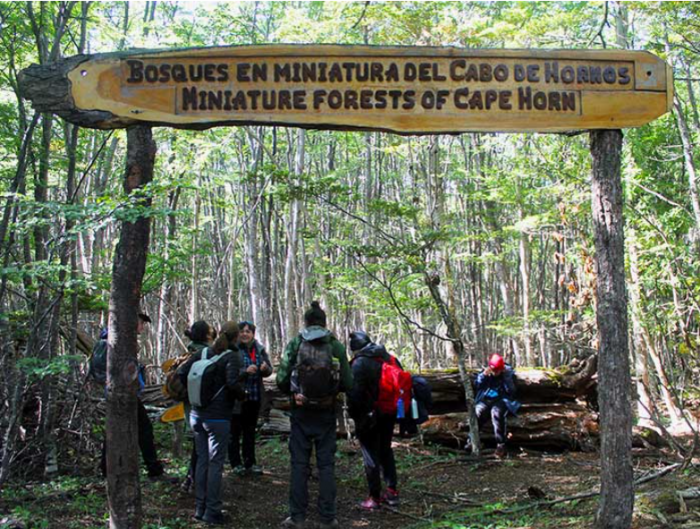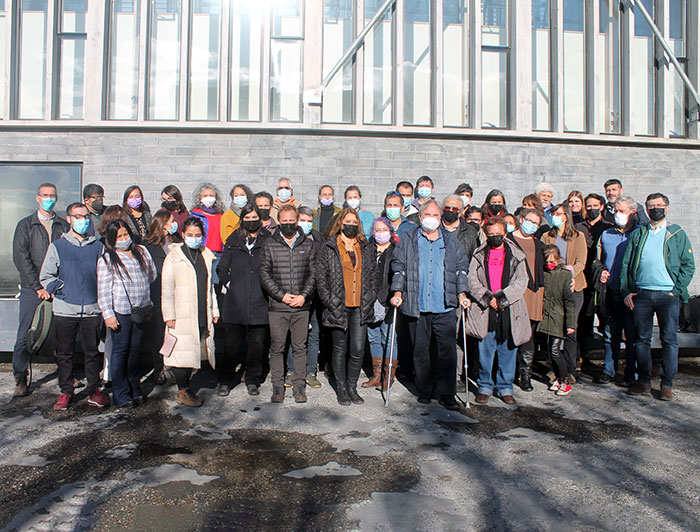
CHIC Project: A Look at Climate Change from the Far Reaches of the World
The Cape Horn International Center, a consortium of seven universities, seeks to study and monitor how sub-Antarctic ecosystems respond to climate change. Through a novel biocultural approach, the center combines science, education, anthropology and environmental ethics.

photo_camera The Cape Horn Biosphere Reserve is one of the few pristine places left in Chile and the world. This "natural laboratory" is perfect for the study of climate change, which is the whole point of the project. (Place: Dientes de Navarino / Photo credit: Nicole Saffie)
When you make the trip from Punta Arenas to Puerto Williams, towards Navarino Island, you can see the Strait of Magellan, the mythical Beagle Channel and the majestic Cordillera Darwin, the highest peaks of Tierra del Fuego.
Here you really feel like you are in the far reaches of our continent.
Far Reaches of the World
This remote location screams wilderness.
Nestled in the Cape Horn Biosphere Reserve, the Magallanes y la Antártica Chilena Region, this is one of the few places left in Chile and the world with almost no human intervention.
It really is a natural laboratory for the study of climate change and diverse biocultural phenomena.
This is exactly the focus of the Cape Horn International Center for Studies of Global Change and Biocultural Conservation (CHIC).
The center will be able to operate for at least 5 years thanks to Funding of Excellence in Science granted in November 2021 by the National for Research and Development Agency (ANID, as per its Spanish acronym), which can be expanded to 10 years.
The goal of the center is to design and evaluate:
- Socio-environmental policies
- Sustainable economic activities
- Educational methodologies linked to conservation and biocultural heritage
- Management plans for the southernmost marine and terrestrial protected areas of the continent
The project will focus on 3 research lines:
- Climate change
- Biocultural homogenization
- Environmental, economic and social sustainability
Keep reading to learn about each one.

The Effects of Climate Change
The first line of research, “Sentinels of Climate Change,” addresses terrestrial (land), freshwater (rivers) and marine (sea) ecosystems.
As CHIC director Ricardo Rozzi explained, “Integrating the three ecosystems is an innovation, but we have to do it in this way because Cape Horn is an archipelago. You cannot understand terrestrial [ecosystems] without the marine side, and its connections are the rivers.”
- Terrestrial Area
Frederick Thalasso, researcher at the Universidad de Magallanes, will be in charge of this area and study greenhouse gases in peatlands and forests.
Biologist Mary Kalin will investigate how plants respond to global warming.
Juan Carlos Aravena, director of the Antarctic Research Center of the Universidad de Magallanes, will research the changes experienced by the tree line in the face of this phenomenon.
- Freshwater Area
The objective of this area is to find out why insects have more than one life cycle per year as temperature increases. Tamara Contador, faculty of the Universidad de Magallanes, will be in charge of this area.
- Costal-Marine Area
This area is led by Andrés Mansilla, the Vice President for Research of Universidad de Magallanes, who explained:
“We address coastal-marine-oceanic biodiversity. We study all organisms, algae, primary producers, and fauna, at the level of taxonomy and also genomics.”
“We gather all this knowledge and see the possible applications of these basic studies, but linked to local communities, Indigenous communities and artisanal fishing, in order to rescue their knowledge and transfer it to promote tourism, gastronomy and biomedicine.”
Biocultural Homogenization

The second line of study is “Sentinels of Biocultural Homogenization.”
Its central concept is that, just as culture is homogenized—with fast food, consumer products, urbanization, among others—biota, that is, plants, animals and other living organisms are also homogenized.
“For example, eucalyptus monocultures are replacing native forests, salmon are replacing the diversity of fish, beef is replacing the variety of meats, and so on. This is happening all over the world,” said Rozzi.
According to him, this is an innovative approach, which seeks to make a global contribution, thanks to its collaborative work with different ecosystems, including:
- The Reserva de la Biósfera El Cielo [El Cielo Biosphere Reserve], in the state of Tamaulipas in Mexico
- The Reserva de la Biósfera de Galápagos [Galapagos Biosphere Reserve] in Ecuador
- The island of Ancheta in Brazil, together with the Universidad de São Paulo, the scientific park of this city, the Cientec
- The Araucanía Region in Chile, together with the UC Chile Campus Villarrica.
The objective is to evaluate and compare this phenomenon, how it happens, its frequency, the level of diversity and what are the opportunities to reverse the situation.
For this purpose, birds will be studied by Rodrigo Vásquez professor of the Universidad de Chile.
“In Chile, the most diverse and abundant vertebrates are birds. Also, at Omora Park, in Puerto Williams, we have the longest continuous study of nesting birds in the southern hemisphere," explained Ricardo Rozzi.
This is in addition to the work that has been developed by Tomás Ibarra, a faculty member from the Villarrica Campus, focused on the reproductive biology of birds; and Tomás Altamirano, from the Universidad de Magallanes.
The purpose is to start an ornithological laboratory in future. Exotic or invasive species—visons, beavers, among others—will also be studied and Elke Schüttler will be in charge of this effort.
At the cultural level, the studies will be led by Andrea Valdivia, anthropologist and faculty member of the Institute of Communication and Image of Universidad de Chile.
In the field of philosophy, Luca Valera, from the UC Chile Bioethics Center, and other researchers from Universidad Católica de Temuco, are working on a perspective of “biocultural ethics”, led by Ricardo Rozzi.
Biocultural Conservation at Multiple Scales
The third line of research, led by Lorena Medina, aims to achieve environmental, economic and social sustainability through research, material design and concrete proposals in three areas:
- Education
- Gastronomy “of the reaches of the world”
- Sustainable tourism and protected areas
In education, the first thing to do is to initiate a dialog of mutual knowledge to promote joint work, then to diagnose what the educational communities of Puerto Williams are working on in the classroom, garden and outdoor workshop level.
Then, as a team, they will propose new methodologies, design and implement education programs and materials for biocultural conservation.
The work will be carried out jointly with teachers from Liceo Donald McIntyre Griffiths in Puerto Williams, and teachers from the Junji, Tánana and Ukika kindergartens, and the Pequeños Colonos Navy kindergarten.
As she explained: “Our approach to education is based on considering learning as a situated experience. Children can have the opportunity to learn from their territory, to know and value their culture, and those who live there.”
Tomás Llanos will be the Field Education coordinator of this sub-line, while the director of FabLab Austral and UC Chile Design professor Tomás Vivanco will be participating as an associate researcher. The Liceo and the community of Puerto Williams have been cooperating with this UC Chile initiative for some time now.
Another area is how to educate for sustainable food with local resources. José Miguel Aguilera, professor of UC Chile Engineering and winner of the National Award for Applied and Technological Sciences, is in charge of this area, with the collaboration of Pedro Bouchon, Vice President for Research, member of the School of Engineering and a specialist in structure, design and food processing.
For Bouchon, his idea is to “Work together with small and medium-sized agriculture, as well as the small food processing industry, to make good use of local raw materials—of high nutritional value—in a sustainable way, helping the biological and cultural conservation of the area.”
Regarding tourism, the Subantarctic Center will house, for the first time in the area, a professional technical school to offer the first technical career in tourism. The first students are expected to arrive in 2023.
Research will also be done:
- In the area of biocultural heritage, by archaeologist Flavia Morello, director of the Patagonia Institute at the Universidad de Magallanes.
- In protected areas, led by Francisca Masardo; the biosphere reserve model, which combines preservation with sustainable economy, will be analyzed.
An Extraordinary Work Across Disciplines
Led by Universidad de Magallanes, CHIC is formed by a consortium of seven universities, including:
- Pontificia Universidad Católica de Chile (UC Chile)
- Universidad de Chile
- Universidad Central
- Universidad de Talca
- Universidad Católica de Temuco
- Universidad de Los Lagos
The Patagonia Ecosystems Research Center (CIEP, as per its Spanish acronym) and the Regional Government of Magallanes and the Chilean Antarctic are also part of the consortium.
Its director is philosopher and biologist Ricardo Rozzi, a professor at the University of North Texas and the Universidad de Magallanes.
Its deputy director, during the first year, will be Mary Kalin, professor of the Universidad de Chile and National Award of Natural Sciences.
Then she will be succeeded by Lorena Medina, a faculty member and former dean of the UC Chile Faculty of Education.
Its headquarters will be located in:
- Puerto Williams, in a facility built with regional funds known as the Cape Horn Subantarctic Center, opened in November 2022.
- Santiago, in an office in the Dean’s Office of the UC Chile Faculty of Education, at the San Joaquin Campus.
There are 14 principal investigators who, together with the associated researchers and other invited researchers, total more than 80 people.
They are joined by an important group of undergraduate and graduate thesis students, postdocs, and an administrative and professional support team for project management.
It is not common for a transdisciplinary team to apply for funding in natural sciences, but that is exactly what happened in this case. The team is made up of:
- Ecologists
- Marine biologists
- Food engineers
- Researchers in the area of social sciences, philosophy and education
According to Lorena Medina, “It was a daring move. Scientists realized that they needed to add pedagogical knowledge to train new generations in biocultural conservation education.”
According to Vice President for Research Pedro Bouchon:
“Working at the Cape Horn Subantarctic Center, the southernmost research center in the world, will allow us to understand certain keys to the conservation of the Magallanes sub-Antarctic area through science, education and sustainable tourism.
The CHIC project will contribute to this interdisciplinary research, in connection with the territory, aiming to understand the global socio-environmental changes, especially in the Cape Horn Biosphere Reserve, but also including reserves in the Araucanía Region (further north).
UC Chile will do this, together with teams of education, engineering, philosophy, design and the Villarrica Campus, enriching the work of the UC Chile Network of Regional Centers and Stations.”
UC Chile Research Director María Elena Boisier added:
“As an institution, we are in charge of the project's education line, where several faculty members from the Faculty of Education, Villarrica Campus (through the Regional Development Center) and UC Chile FabLab Austral participate, hoping to generate a strong relation with the community.
We also contribute to another area that has to do with Food Engineering, where we seek to generate new products or uses of traditional foods of the region. We also hope to build human capital and empower faculty members and researchers in the project.”
A New ‘CHIC’ Approach

CHIC faces several challenges.
For Lorena Medina, the first is “to be a real contribution to the community of Puerto Williams and later to other similar communities. [We need to determine] how we are able to engage with the community in a way that is healthy, productive and for their own well-being.”
“Another challenge is how to restore an education for biocultural conservation based on respect among co-inhabitants of a territory, and also on its valuation and knowledge. This can be achieved when you know the local wealth and heritage and when you live in a community, and we believe that this should be done from early childhood.”
The faculty member also highlights the importance of having a transdisciplinary team.
Also, as Andrés Mansilla argued, this project is a contribution to decentralize the sciences in the country and to make natural laboratories more visible, giving them value.
CHIC seeks to be a focal point for the study of climate change for the rest of the world.
“Since we live in a geographically privileged place, we have the responsibility of looking at the world and the problems of climate change at a global level,” said Lorena Medina.
As Ricardo Rozzi concluded:
“The general metaphor of CHIC is that, just as the telescopes in Atacama are to observe the macro cosmos, here in the south we have magnifying glasses to look at the micro cosmos. These magnifying glasses are worldviews, languages, education and also small organisms. We are proposing a different way of looking at things.”


